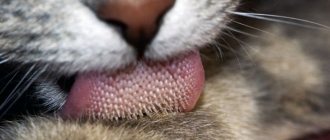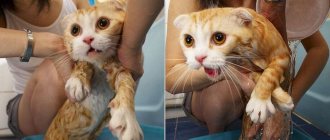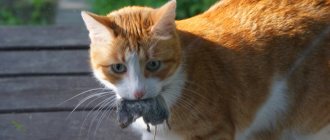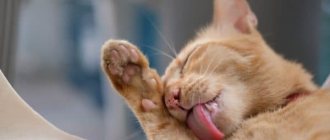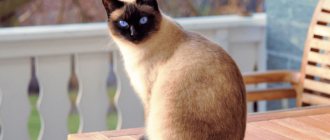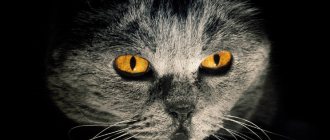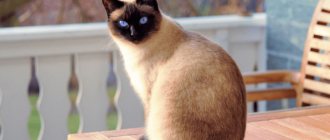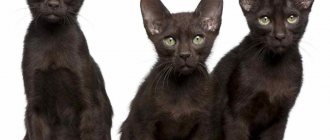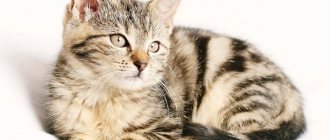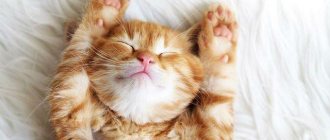If you look into history, you can also find images of cats in rock paintings. There is a version that the ancient Egyptians tamed wild animals from the cat family. The coexistence of cats and humans began about 10-15 thousand years ago. According to one version, the ancestor of the first domestic cat was the North African steppe cat; it was domesticated in Nubia, after which the animals began to be imported to Egypt and Asia. It was there that interbreeding with wild Bengal species occurred.
Ancestors of the domestic cat
According to the official version, the first representatives of the cat family were creodonts, although there is no direct evidence of this. They were much larger in size than the tiger and even more so our pets.
Creodont
Creodonts lived on Earth 50 million years ago. They were dangerous predators, instilling fear in all other animals. Then lions, saber-toothed tigers, and cheetahs appeared.
The domestic cat does not have a specific ancestor. Over the course of thousands of years, its phenotype and genotype have been formed. This path can be traced through animals living in different parts of the planet.
In Africa you can find the long-legged reddish-gray Libyan cat. She has a sharp muzzle, a long narrow body, color with stripes in the form of waves, small specks, dark rings in the tail area.
Stories of the appearance of purebred cats
Cat breeds appeared thanks to the selective work of people, but certain species arose due to gene mutations. There are also native breeds of pets, that is, those that appeared in isolated areas, they are classified as naturally formed breeds:
- Siberian;
- Angora;
- Thai.
Some breeds are hybrid. They arose as a result of the mating of wild and domestic individuals. The Bengal cat is usually classified as a hybrid cat; Asian leopard wild cats and domesticated pets participated in the creation of the breed.
Mysterious versions of the origin of cats
The cat is such a mysterious and mythological creature that people do not always believe in its ordinary origin. Let's look at the most common versions.
Bible version
The Bible contains information about Noah's Ark, which became a salvation for animals. There were no cats then, and mice and rats multiplied so quickly that the rest of the population no longer had enough food supplies. Then God decided to save all the inhabitants of the ark from hunger by ordering Noah to stroke the lion’s nose. Thanks to this, a cat appeared, caught the mice and thereby saved the rest of the animals.
Alien cats
In Egypt, these animals were very loved and revered, as evidenced by ancient images. There is a version that this is where the cat aliens flew. They were completely bald and could communicate with the Egyptians mentally.
There is a story that one of these cats met a shaggy steppe cat while walking in the forest. She fell in love and did not fly to another planet with the others. The alien cat was happy with her cat, giving birth to furry offspring - the ancestors of our pets.
Children of the Sun God
Pharaoh Akhenaten claimed that he was the son of the Sun God, and his half-brothers and sisters were cats. Now this seems fantastic, but even Pythagoras adhered to this version. He put forward a hypothesis of the unearthly origin of cats, but no one believed him. Considering the contributions Pythagoras made to science, this seems surprising.
Inhabitants of the Moon or distant stars
Plotinus (a Neoplatonist philosopher) argued that cats came to us from the Moon. They are well oriented in the dark, active at night and their behavior is directly influenced by the phases of the moon.
Modern felines
All modern cats belong to the family of mammals and the order of carnivores. Their sizes can vary from 30 centimeters to almost 4 meters in length. Weight varies from 1 kg to 300 kg depending on the type.
© shutterstock
All cats have many common characteristics:
- when walking they step on their toes;
- there are 5 toes on the front paws, 4 toes on the hind paws;
- claws can be retracted and extended (in almost all species);
- number of teeth – up to 30;
- the rough surface of the tongue, thanks to which you can clean your fur and lick the remains of meat from the bones of prey;
- the ability to hear high-frequency sounds inaccessible to humans;
- small cats purr as they inhale and exhale, and large cats purr as they exhale.
All modern cats are divided into two subfamilies:
- small cats;
- big cats.
When compiling this classification, phenotypic classifications as well as genotypic lines were taken into account. Previously, in addition to large and small cats, there was also a subfamily of saber-toothed cats, which became extinct about 11 thousand years ago.
Small cats include the following genera of felines::
- Asian cats;
- cheetahs;
- golden cats;
- caracals;
- catopums;
- cats (including domestic cats);
- marble cats;
- cougars.
- lynx;
- servals;
- tiger cats;
Previously, cheetahs were classified into a separate subfamily - cheetahs. But thanks to modern science, studies have been carried out on the genes and genetic relationships of cheetahs, and their close relationship with pumas was discovered.
© shutterstock
Big cats include the following genera of the cat family:
- clouded leopards;
- panthers (which include lions, tigers, leopards, jaguars, leopards).
The word "panther" often refers only to black-colored cats, and there is a stereotype that it is a separate species. But the black color appeared as a result of a mutation in the gene responsible for pigmentation. The most common black panthers are leopards and jaguars.
Felines live on land, preferring forests, deserts, and mountains. Most of these animals live in the tropics and subtropics, but some species are also found in temperate climates.
Cats appeared on the planet several million years ago and now wild cat species are present in all corners of the planet. The only exceptions are Australia, Antarctica, Greenland, Madagascar, Sulawesi, and New Guinea.
A distinctive feature of the entire cat family is that they have approximately the same habits and habits. After observing a domestic cat, you will notice that its behavior is practically no different not only from a street cat, but also from a “relative” of another subspecies that has spent its entire life in the wild, hunting and fighting with other animals.
Relations with humanity
| ◄ ► |
A cat with heterochromia looks into your soul
Juliana of Norwich looks at you as a cat lover
| « | I think that after, as a result of the revolution, Moscow becomes the Free Zalesskaya Commune within the European Union, all dogs should really be exterminated, but cats should be given divine honors, as in Ancient Egypt, most Orthodox churches should be converted into sanctuaries of a new cult, where every homeless cat will be able to receive shelter and delicious food, and in the former Cathedral of Christ the Savior, a statue of the Pallas's cat will be erected and the few remaining dogs, as well as all those who dare to offend the sacred cats, will be regularly sacrificed in front of it. And the lions and tigers will be fed by Christians. | » |
| - anglares, azatiy | ||
For completely irrational reasons, in many bipeds, the very sight of a cat going about its feline business, for example, evokes a reaction of affection, a desire to grab the animal, stroke it, pat it, saying in an idiotic voice “what a kitty,” “what a cat,” “what a cat,” “what a cat.” kitty-kitty”, “who is so handsome”, etc. For equally irrational reasons, in another part, the very sight of a cat going somewhere about its cat business causes a reaction of irritation and a desire to kick the cat, scare it or simply call it bad words. Others don't care.
Many imageboards have sections dedicated to this creature. They are usually called /ne/ (from Japanese neko
- subject). In addition, sub-cats happen regularly on //.
In particular, cats make up slightly less than the entire content of a typical daily diary (one of the most famous blogs about cats in RuNet is the Diary of Unnecessary Cattle, also known as Notes of the Plinth Cat). For some reason, other animals are not given such attention.
Juliana of Norwich was born on November 8, 1342, a Benedictine nun, an English spiritual writer, and the first woman to write a book in English. “All shall be well” is the most famous quote from her book. Juliana of Norwich is often depicted with a cat and is considered the patroness of cats.
Where did Sphynx cats come from?
In fact, there are a huge number of sphinx breeds and not all are popular. Where did hairless cats come from? This question torments many people. Descriptions of hairless cats have been available since ancient times; the Aztecs could have been their owners.
At all times, hairless kittens have been born on the territory of our planet. They were of no interest to people and were simply destroyed. A resident of Canada was the first to decide to breed the breed when, in 1966, he discovered a hairless cat in his cat’s litter. The baby was named Prunt and later brought together with his mother. Both normal and hairless kittens were born again. Then hairless cats and female cats were bred until shaggy creatures completely disappeared from the litters. This is how the now popular sphinxes appeared, and they owe their origin to an ordinary mutation.
What if the legend is true, and once upon a time hairless alien cats visited our Earth, and now cats give birth to hairless kittens, reminding them of their origin? This will forever remain a secret!
Where did Siamese cats come from?
The Siamese cat, which many associate with a demon, originated in Thailand between 1350 and 1750. This is a purebred animal, and man made no effort to breed the breed.
The first Siamese are described in writings from the 19th century. It says that these cats were considered sacred animals and were kept in Buddhist temples. Only priests and royal families were allowed to have them.
Today everyone can afford this breed of pet; they are bred in nurseries.
The appearance of cats in Rus'
Excavations carried out in Russia and the former Soviet Union have shown that cats appeared on our lands in the seventh century. But the first descriptions of these animals are in documents dating back to the eleventh century. It is assumed that foreign sailors brought strange animals to Russia and sold them for huge sums of money. People liked this creature, because its eyes glow in the dark, and from any height it falls on all four paws, and even purrs!
Over time, the cats began to breed and multiply, and now in the peasant huts the beast caught mice and rats, protecting the owner's supplies.
There is a legend that Peter the Great himself adored these creatures and, seeing how another cook was chasing a fluffy one, declared cats to be inviolable creatures. You may ask, why does a chef need a cat? This animal simply brought him a dead rat as proof of its work and irreplaceability and placed it on the cutting table. That's all. But since then no one could offend the tailed one in Rus'.
NASA says aliens look like cats
Perhaps it was not for nothing that in the Middle Ages people believed that the cat was an unearthly creation. Not long ago, everyone was stunned by the news about the discovery of American astronauts. The guys landed on the moon and found many unusual objects there. They resembled small coins in size. Having brought the artifacts with them, the astronauts sent them to the laboratory. The result of the analysis simply shocked everyone: a similar composition exists on Earth, this is cat feces. Well, tell me, where did they come from on the Moon?
Since then, NASA scientists began to develop the hypothesis that cats are real aliens and all aliens look exactly like this!
Instructions for using cats
| « | - So, Greg. Why don't you like cats? — I don’t “don’t like cats.” I'm just more of a dog person. I prefer dogs. I love the way they wag their tail when they see you... - Do you need adoration? And that's why you prefer emotionally limited creatures? - I... - You see, Greg: you just have to shout at the dog, and he will lower his tail to the bottom, covering his genitals with it, and press his ears. Cats are not as corrupt as dogs; they force everyone to work for themselves. Dog too easy tame. | » |
| — “Meeting the Parents” | ||
| ◄ ► |
95% of cat owners are idiots
Kote will give you advice for all occasions
Lyapapam
Busy!
Freya literally rides cats
- Only rude, uncouth people can find sadistic pleasure in grabbing Cats by the scruff of the neck and dragging them back and forth. Cats are supposed to be picked up with both hands under their soft, plump belly and carried around the apartment, affectionately calling them “nasty animals,” “nasty little animals,” or “good cats.”
- Young, not yet heavy Cats can be launched. The Cat is launched by accelerating the Cat in the horizontal direction approximately a meter above the bed. Launched, the Cat flies for some time, spreading its legs like a flying squirrel, after which it lands with a soft sound, springing beautifully and immediately rushing to run away in horror. An escaped Cat can be easily lured back by starting to make rustling or scratching sounds. Hearing such sounds, the Cat immediately returns back in the hope of catching the mouse. The Cat deceived in this way can be immediately launched again.
- In Savet times, it was also practiced to launch parachute cats from the roofs of houses, but very often they were blown onto balconies and windows of houses.
- When in a bad mood, the Cat can hit you with its paw. Some improperly raised cats will release their claws and scratch. A well-trained cat is afraid to go out into the middle of the room and never lets out its claws against its owners and paws very pleasantly with its soft paw. Having become completely angry, the Cat presses his ears to his head and waves his paw with all his might, which is very funny. It's more expensive to anger true cats.
- As a means of transportation: if you have a cat larger than yourself, one animal is enough. Otherwise, a larger number of baleen are needed. A simpler way (or more complicated, depending on how you look at it): become a goddess like Freya, who rode around in a chariot with two white cats harnessed to it. Pathetic!
- Guard cat.
- Never leave
- In the harsh Siberian winters, cats can be used as mobile heaters by placing a feline on your chest or blanket to keep them warm.
- There is a belief that a cat with parquet flooring tied to its back cannot turn and can only walk in a straight line.
- Another belief says that if you cut off all of a cat’s whiskers, he will walk around the house and poke into all the objects, unable to adequately assess the distance to them. In fact, with the help of whiskers, cats detect air movement in the room, and without them they feel extremely insecure, especially in the dark.
- Many owners, in a fit of tenderness, can completely irrationally call their cats bunnies, fish, cats, bear-bears and other inappropriate feline animals.
- A large collection of rules for the correct use of cats in everyday life is available in the very Orthodox book of the racial British writer Terry Pratchett, “Cat No Fools.”
Wild Middle Ages
I would like to take a little break from thinking about where cats came from and talk about their role in human life. Now these animals are not in danger, but just recently cats were subjected to terrible torture and executions. People believed that purrs were assistants to witches and the devil himself and burned them at the stake.
There was another, no less terrible, killing of cats. During the Middle Ages, once a year a holiday was held in the city of Ipern, it was called “Cat Day”. For the cats themselves, this day did not bode well; they were thrown in huge quantities from the highest towers.
In the 18th century, a bishop from Germany ordered all cats to have their ears and tails cut off, while at the same time the kings of France had fun watching purring cats suffer at the stake.
A nightmare, and that's all. Only in Egypt were cats deified, cared for during their lifetime, and all representatives of the tailed family lived in luxury. After death, cats were mummified and buried next to the pharaohs.
In Russia, from the very beginning, this beast was not considered by people to be either a god or a devil; it was kept for catching mice and rats. By the way, where did cats come from in Russia?
Links
- KOTE, LOTS OF KOTE!
- KoTe on blogs in general and JoZhe in particular.
- Cats as beards on that Tape.
- And even among anime fuckers!
| [ + ] Who said ? Cat! | |||||
| |||||
| [ + ] “Cat” is a word that has a real connection with Upyachka!1 Note to all UPChK soldiers11 | ||||||
| ||||||
BC
The first mammals, among which predators also appeared, were creodonts. About 75 million years ago, this group of animals was very numerous, and included various species of omnivores and scavengers. About 50 million years ago, the miacids evolved from the creodonts. These were animals with more developed intelligence than their predecessors. Externally, the miacid resembled an ermine or a weasel - an elongated body and head, short legs, a long tail and a flexible spine. Cats appeared about 40 million years ago, when the evolution of miacids took two paths. The first group of animals is considered the ancestors of all canines. Representatives of the Viverravines group may have been the ancient ancestors of modern cats. Fossa, a unique animal from the island of Madagascar, according to some scientists, is a transitional form of prehistoric viverrids to representatives of the felines.
The appearance of cats is often associated with proailurus. This extinct animal was a very nimble and fast, flexible and ruthless hunter. He spent most of his time in the trees, descending from the branches only in search of prey. Interestingly, prehistoric cats changed little compared to other animal species: during evolution, the size of the brain increased, the muzzle became shorter, and the limbs became slightly longer. About 140 thousand years ago, the steppe cat appeared - one of the subspecies of the forest wild cat. The steppe, African or spotted cat still lives in the desert, mountain and steppe regions of Asia, Africa, India, Kazakhstan and Transcaucasia. These are small animals weighing up to 7 kg, wearing striped coats of a sandy-grayish color.
The appearance of the domestic cat is associated precisely with its closest “steppe” relative. Previously, it was believed that the ancestors of domestic cats were also representatives of other species of small cats - sand cats, European forest cats, and jungle cats. However, recent genetic studies refute this theory.
